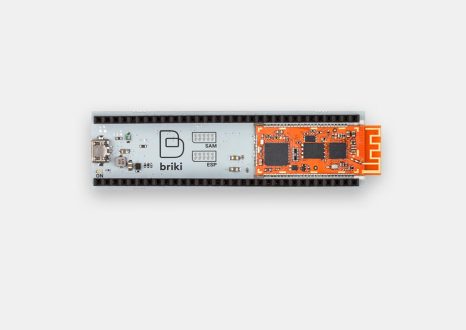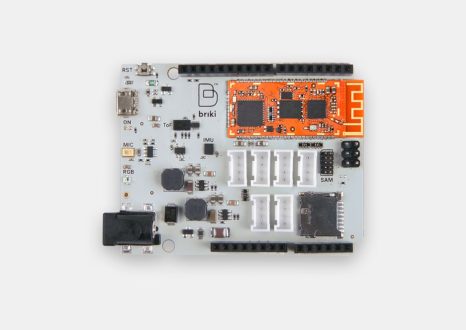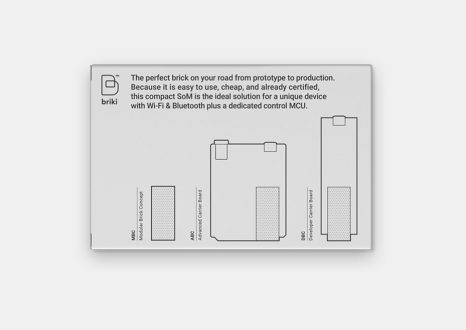PRODUCTS
Briki MBC-WB
Wi-Fi & Bluetooth Device
OVERVIEW
This compact System on module (SoM) is the ideal solution for designers who want a unique device with Wi-Fi & Bluetooth plus a dedicated control MCU.
From prototype to product in a simple and fast way
Exposed debug interfaces for both the chips
Small “1-Brick” form factor with many GPIOs
Compatible pinout between all modules in the family
Liquid logic to surpass the classical rigid master/slave topology
Embedded flash memory for both, code and user storage
Dual-level of embedded security, from cloud to boot
Multi-language support (C/C++ and python)
Dual wireless interface (BLE/BT and Wi-Fi)
FEATURES
Product size: 38 x 16 mm
Format: 1 brick
- ATSAMD21G18A ARM® Cortex®-M0+ running at 48MHz
- ESP32-D0WD dual-core Tensilica Xtensa LX6 running @240MHz
- Internal / External QSPI 16-Mbit, 64-Mbit or 128-Mbit flash
- PCB Antenna integrated
- CryptoAuth ECC608B chip
This product is sold by request as products for industrial use.
The MBC module is available in different versions by hardware configuration and functionalities. Depending on your design, you may prefer one version over the other. Contact us to find the best suited for you!
REQUEST PRODUCTDOWNLOAD
Documentation
Download all
Datasheet
Pin description
Certifications
User manual
Please make sure you are logged in or registered to the website to access all the documents.
FW & SW TOOLS
Meteca offers a complete firmware solution for both the MCUs, written in C/C++ and fully compatible with Arduino for a fast and simple prototyping process.
All Briki MBCs are completely programmable using the Arduino IDE or a more professional IDE like Visual Studio Code. The latter, in particular, allows customers to program both the MCUs using different programming languages and/or SDK like Microchip’s ASF, Espressif’s esp-idf or python.
Both the MCUs have their debugging interface exposed on the module’s pinout to ensure full control over the firmware implementation. In conjunction with Visual Studio Code, several debugging devices can be used to extensively debug the code: ATMEL ICE (link) for the ARM Cortex MCU and/or Segger J-Link (link), useful for both the Cortex and the Tensilica ESP32.
The software suite offered includes a set of tools specifically designed to allow firmware update procedure (via USB or OTA for both the MCUs), ESP32’s memory mapping along with automatic pin-mapping configuration.
DEVELOPMENT TOOLS
There are two different development boards specifically designed to address different customer needs, aimed at helping you customize your project with the MBC module. Choose the one that’s right for you, or try both of them with the dedicated Development Kit!
FREQUENTLY ASKED QUESTIONS
FAQ
The two microcontrollers communicate with each other using the SPI interface and/or the UART plus some synchronization signals. A communication library (written in C/C++) is available for both the peripherals allowing bidirectional commands and data exchange. Besides, both microcontrollers can communicate with external devices thanks to their communication interfaces: UART, USB, SPI, I2C and so on. For further details and for peripherals mapping on MBC’s pins you can refer to the MBC datasheet and the MBC’s User Manual.
Depending on the MBC model chosen and the technology it embeds, the operating voltage may vary considerably. Always read the instructions carefully, which is available in the module’s documentation you want to use. The MCB-WB must be powered at 3.3V. This is the operating voltage for both the microcontrollers
Depending on the MBC model chosen and the technology it embeds, power consumption may vary considerably. Always read the instructions carefully which is available in the module’s documentation you want to use . MBC-WB: the module power consumption depends on the operating conditions, active peripherals and working frequencies. Current consumption may vary from few uA (microamperes) up to 0.5A (Ampere).
Depending on the MBC model chosen and the technology it embeds, there may or may not be one or more RF interfaces. Always read the instructions carefully which is available in the module’s documentation you want to use.
The MBC-WB is compatible with Wi-Fi 2.45GHz (IEEE 802.11 b, g, n) standard, with Bluetooth v4.2 BR/EDR and BLE with class-1, class-2 and class-3 transmitter.
Depending on the MBC model chosen and the technology it embeds, OTA functionality may or may not be available. For those modules that provide the OTA functionality, all the MCUs present on the board can be programmed using this feature. Using the OTA Tool provided by Briki, it’s possible to select the micro for the firmware update procedure.
The MBC-WB is compatible with Wi-Fi 2.45GHz (IEEE 802.11 b, g, n) standard, with Bluetooth v4.2 BR/EDR and BLE with class-1, class-2 and class-3 transmitter.
Depending on the MBC model chosen and the technology it embeds, the USB interface may or may not be available. For those modules that provide the USB interface, all the MUCs present on the board can be interfaced and programmed using this interface. The firmware update procedure can be done both by using the MBC Tool provided by Briki or by using one of the supported IDE as well.
If you still haven’t resolved your doubts, or do you need more information about this product please contact us.
CONTACT US

